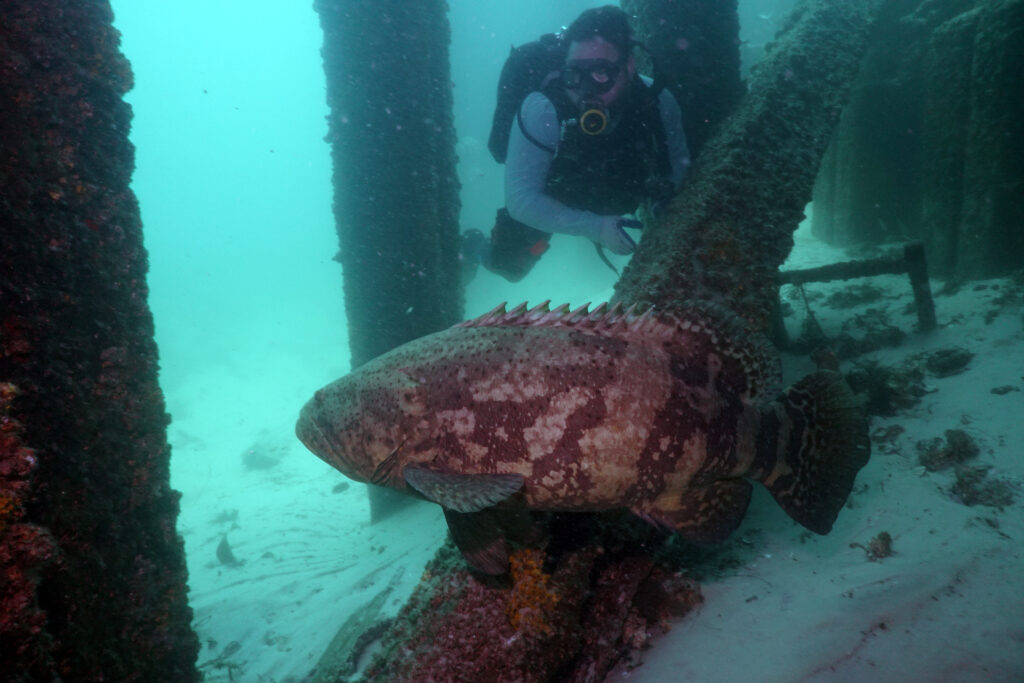April marks Participatory Science Month, also known as Citizen Science Month. Florida Sea Grant proudly celebrates the contributions of individual volunteers in coastal and marine research. Whether seasoned participants or newcomers, their efforts in monitoring coastal habitats or tracking wildlife have a profound impact on research and conservation efforts statewide.

Mike Norberg diving next to a Goliath grouper. Image by Mike Norberg.
Picture yourself descending hundreds of feet below the ocean’s surface, when suddenly, you come face to face with an enormous 800-pound fish. This breathtaking encounter is exactly what our Great Goliath Grouper Count (GGGC) volunteers such as Mike Norberg get to experience, during his yearly participation in the citizen science diving program.
The GGGC program provides a snapshot of goliath grouper abundance and size distribution at surveyed reef sites across a wide geographic area, thanks to partnerships with organizations like Florida Sea Grant, the Florida Fish and Wildlife Conservation Commission (FWC), and county partners like the Okaloosa County Coastal Resource Team.
Mike’s journey with the GGGC began in 2021 when he joined the team as a coordinator. He and his team immersed themselves in various projects, from deploying artificial reefs to conducting marine research on sea turtles and lionfish.
As a coastal coordinator, Mike and others on the team play a pivotal role in the GGGC, dedicating their time, expertise, and passion to marine life.
“Data on the Gulf of Mexico, especially in the Panhandle region, is noticeably scarce. This presents a golden opportunity to participate in data collection actively, witness Goliath groupers in their natural habitat, and contribute to meaningful research,” says Mike.
Despite 26 years of diving and three years of conducting surveys with the GGGC, every encounter with a Goliath grouper remains monumental for him.
“We’ve spotted numerous Goliath groupers off the shores of Destin-Fort Walton Beach, ranging from juveniles to impressive adults measuring up to 5 feet. During one dive, we observed four Goliaths of various sizes, one of which was a whopping 5 feet long. Being a part of this program allows me to focus my efforts on something I would not have before.”
Data on the Gulf of Mexico, especially in the Panhandle region, is noticeably scarce. This presents a golden opportunity to participate in data collection actively, witness Goliath groupers in their natural habitat, and contribute to meaningful research.
Mike Norberg
For Mike, participating in the program has sharpened his data collection skills, opening new avenues for recognizing other research opportunities, such as tracking and tagging Goliath groupers.
The GGGC has witnessed significant growth since its inception in 2010, expanding its scope from southwest Florida to encompass sites along the northern Gulf of Mexico and the east coast. Over the past fourteen years, nearly a thousand surveys have been conducted, with divers collectively spending over 470 hours underwater, providing invaluable insights into the population and distribution of Goliath groupers.
Although he is a marine scientist himself, Mike acknowledges that citizens getting involved in participatory science can be intimidating. However, with a bit of stepping out and engaging with the community, it can be easier.
“Building familiarity among participants is crucial. By reaching out to fellow participants, reviewing shared data sheets, and fostering a sense of community, especially amongst stakeholders, you can continue to significantly impact understanding and protecting marine ecosystems,” says Mike.
Read more about Mike’s experience with the Great Goliath Grouper Count throughout his years with the Okaloosa County Coastal Resource team here.